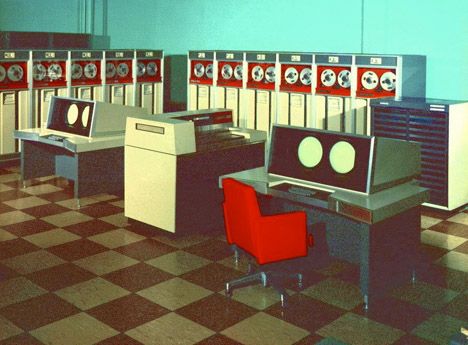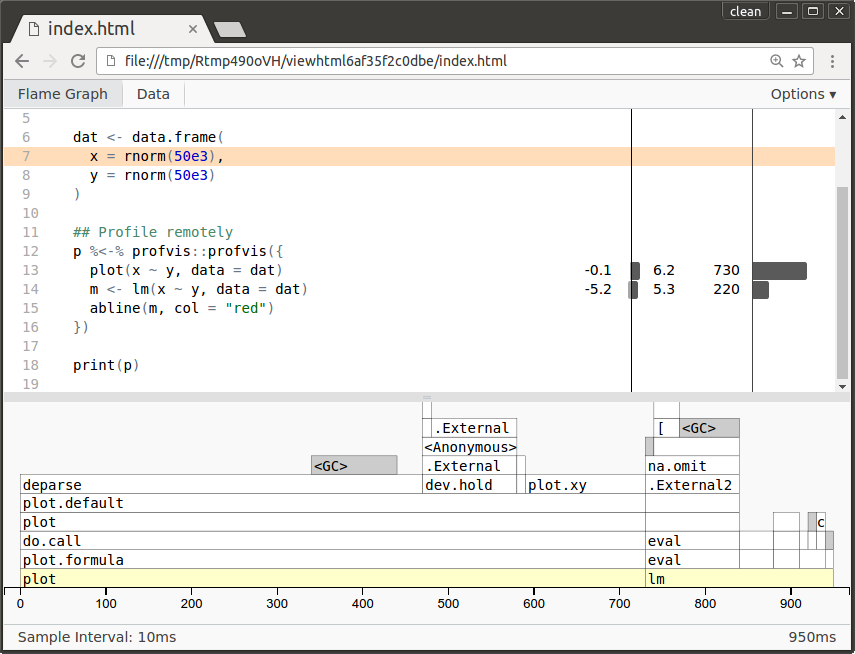Future: Friendly Parallel and Distributed Processing in R for Everyone

Henrik Bengtsson
- SatRday LA 2019 - Organizers, Volunteers, and Sponsors
- R Core, CRAN, devels, and users!
- R Consortium
Why do we parallelize software?
Parallel & distributed processing can be used to:
speed up processing (wall time)
lower memory footprint (per machine)
avoid data transfers (compute where data lives)
Other reasons, e.g. asynchronous UI/UX
Concurrency in R
X <- list(a = 1:50, b = 51:100, c = 101:150, d = 151:200)y <- list()y$a <- sum(X$a)y$b <- sum(X$b)y$c <- sum(X$c)y$d <- sum(X$d)y <- list()for (name in names(X)) y[[name]] <- sum(X[[name]])y <- lapply(X, FUN = sum)How do we parallelize in base R? since R 2.14.0 (Nov 2011)
X <- list(a = 1:50, b = 51:100, c = 101:150, d = 151:200)y <- lapply(X, FUN = slow_sum) # 4 minutesThis can be parallelized on Unix & macOS (becomes non-parallel on Windows) as:
y <- parallel::mclapply(X, FUN = slow_sum, mc.cores = 4) # 1 minuteTo parallelize also on Windows, we can do:
library(parallel)workers <- makeCluster(4)clusterExport(workers, "slow_sum")y <- parLapply(workers, X, fun = slow_sum) # 1 minutePROBLEM: Different APIs for different parallelization strategies
Developer
"Which parallel API should I use?"
"What operating systems are users running?"
"It should work ... Oh, I forgot to test on macOS."
User
"Weird, others say it work for them but for me it doesn't!?"
"I wish this awesome package could parallelize on Windows :("
"I wish we could use a compute cluster in the cloud to speed this up"
PROBLEM: Code clutter + error prone
#' @import parallelmy_fun <- function(X, ncores = 1) { if (ncores == 1) { y <- lapply(X, FUN = my_sum) } else { if (.Platform$OS.type == "windows") { workers <- makeCluster(ncores) on.exit(stopWorkers(workers)) clusterExport(workers, "slow_sum") y <- parLapply(workers, X, fun = slow_sum) } else { y <- mclapply(X, FUN = my_sum, mc.cores = ncores) } } y}SOLUTION: Encapsulate these problems
library(foreach)doMC::registerDoMC(4) # User chooses how to parallelizemy_fun <- function(X) { foreach(x = X) %dopar% { slow_sum(x) }}workers <- parallel::makeCluster(4) # Alternative parallel backenddoParallel::registerDoParallel(workers)Error in { : task 1 failed - 'could not find function "slow_sum"'
Whoops, we forgot to export slow_sum() to background sessions;
foreach(x = X, .export = "slow_sum") %dopar% { slow_sum(x) }The Future ...

A Future is ...
- A future is an abstraction for a value that will be available later
- The value is the result of an evaluated expression
- The state of a future is unevaluated or evaluated
v <- expr
f <- future(expr) v <- value(f)
Example: Sum of 1:100
> slow_sum(1:100) # 2 minutes[1] 5050> a <- slow_sum(1:50) # 1 minute> b <- slow_sum(51:100) # 1 minute> a + b[1] 5050Example: Sum of 1:50 and 51:100 in parallel
> library(future)> plan(multiprocess)> fa <- future( slow_sum( 1:50 ) ) # ~0 seconds> fb <- future( slow_sum(51:100) ) # ~0 seconds> 1:3[1] 1 2 3> value(fa)[1] 1275> value(fb)[1] 3775> value(fa) + value(fb)[1] 5050Two alternative syntaxes
v <- expr
f <- future(expr) v <- value(f)
v %<-% expr
Example: Sum of 1:50 and 51:100 in parallel (implicit API)
> library(future)> plan(multiprocess)> a %<-% slow_sum( 1:50 ) # ~0 seconds> b %<-% slow_sum(51:100) # ~0 seconds> 1:3[1] 1 2 3>Example: Sum of 1:50 and 51:100 in parallel (implicit API)
> library(future)> plan(multiprocess)> a %<-% slow_sum( 1:50 ) # ~0 seconds> b %<-% slow_sum(51:100) # ~0 seconds> 1:3[1] 1 2 3> a + b[1] 5050Many ways to resolve futures
plan(sequential)plan(multiprocess)plan(cluster, workers = c("n1", "n2", "n3"))plan(cluster, workers = c("remote1.org", "remote2.org"))...> a %<-% slow_sum( 1:50 )> b %<-% slow_sum(51:100)> a + b[1] 5050R package: future 
- "Write once, run anywhere"
- A simple unified API ("interface of interfaces")
- 100% cross platform
- Easy to install (< 0.5 MiB total)
- Very well tested, lots of CPU mileage, production ready
╔════════════════════════════════════════════════════════╗ ║ < Future API > ║ ║ ║ ║ future(), value(), %<-%, ... ║ ╠════════════════════════════════════════════════════════╣ ║ future ║ ╠════════════════════════════════╦═══════════╦═══════════╣ ║ parallel ║ globals ║ (listenv) ║ ╠══════════╦══════════╦══════════╬═══════════╬═══════════╝ ║ snow ║ Rmpi ║ nws ║ codetools ║ ╚══════════╩══════════╩══════════╩═══════════╝
Why a Future API? Solution: "interface of interfaces"
The Future API encapsulates heterogeneity
- fever decisions for developer to make
- more power to the end user
Motto: Developer decides what to parallelize - user decides how to
Provides atomic building blocks:
f <- future(expr),v <- value(f), ...
for richer parallel constructs, e.g. 'foreach', 'future.apply', ...
- Automatic support for new backends,
e.g. 'future.callr', 'future.batchtools', 'future.clustermq', ...
Why a Future API? 99% Worry Free
- Globals & Packages: automatically identified & exported
- Static-code inspection by walking the abstract syntax tree (AST)
x <- rnorm(n = 100) pryr::ast( { slow_sum(x) } )f <- future({ slow_sum(x) }) | \- `{ \_____________/ | \- () |_____________| \- `slow_sum | \- `xGlobals identified and exported to background R worker:
slow_sum()- a function (also searched recursively)x- a numeric vector of length 100
Building things using core future building blocks
f <- future(expr) # create future r <- resolved(f) # check if done v <- value(f) # wait & get result

Building things using core future building blocks
#' @import futureparallel_lapply <- function(X, fun, ...) { ## Create futures fs <- lapply(X, function(x) { future(fun(x, ...)) }) ## Collect their values lapply(fs, value)}> plan(multiprocess)> X <- list(a = 1:50, b = 51:100, c = 101:150, d = 151:200)> y <- parallel_lapply(X, slow_sum)> str(y)List of 4 $ a: int 1275 $ b: int 3775 $ c: int 6275 $ d: int 8775Frontend: future.apply 
- Futurized version of base R's
lapply(),vapply(),replicate(), ... - ... on all future-compatible backends
- Load balancing ("chunking")
- Proper parallel random number generation
╔═══════════════════════════════════════════════════════════╗ ║ future_lapply(), future_vapply(), future_replicate(), ... ║ ╠═══════════════════════════════════════════════════════════╣ ║ < Future API > ║ ╠═══════════════════════════════════════════════════════════╣ ║ "wherever" ║ ╚═══════════════════════════════════════════════════════════╝
y <- lapply(X, slow_sum)Frontend: future.apply 
- Futurized version of base R's
lapply(),vapply(),replicate(), ... - ... on all future-compatible backends
- Load balancing ("chunking")
- Proper parallel random number generation
╔═══════════════════════════════════════════════════════════╗ ║ future_lapply(), future_vapply(), future_replicate(), ... ║ ╠═══════════════════════════════════════════════════════════╣ ║ < Future API > ║ ╠═══════════════════════════════════════════════════════════╣ ║ "wherever" ║ ╚═══════════════════════════════════════════════════════════╝
y <- future_lapply(X, slow_sum)plan(multiprocess)plan(cluster, workers = c("n1", "n2", "n3"))plan(batchtools_sge)
Frontend: furrr (Davis Vaughan)
- Futurized version of purrrs R's
map(),map2(),modify(), ... - ... on all future-compatible backends
╔═══════════════════════════════════════════════════════════╗ ║ future_map(), future_map2(), future_modify(), ... ║ ╠═══════════════════════════════════════════════════════════╣ ║ < Future API > ║ ╠═══════════════════════════════════════════════════════════╣ ║ "wherever" ║ ╚═══════════════════════════════════════════════════════════╝
y <- purrr::map(X, slow_sum)Frontend: furrr (Davis Vaughan)
- Futurized version of purrrs R's
map(),map2(),modify(), ... - ... on all future-compatible backends
╔═══════════════════════════════════════════════════════════╗ ║ future_map(), future_map2(), future_modify(), ... ║ ╠═══════════════════════════════════════════════════════════╣ ║ < Future API > ║ ╠═══════════════════════════════════════════════════════════╣ ║ "wherever" ║ ╚═══════════════════════════════════════════════════════════╝
y <- future_map(X, slow_sum)Frontend: doFuture 
- A foreach adapter on top of the Future API
- Foreach on all future-compatible backends
╔═══════════════════════════════════════════════════════╗
║ foreach API ║
╠════════════╦══════╦════════╦═══════╦══════════════════╣
║ doParallel ║ doMC ║ doSNOW ║ doMPI ║ doFuture ║
╠════════════╩══╦═══╩════════╬═══════╬══════════════════╣
║ parallel ║ snow ║ Rmpi ║ < Future API > ║
╚═══════════════╩════════════╩═══════╬══════════════════╣
║ "wherever" ║
╚══════════════════╝
doFuture::registerDoFuture()plan(multiprocess)y <- foreach(x = X) %dopar% { slow_sum(x) }~1,400 packages can now parallelize on HPC
┌───────────────────────────────────────────────────────┐
│ │
│ caret, gam, glmnet, plyr, ... (1,400 pkgs) │
│ │
╠═══════════════════════════════════════════════════════╣
║ foreach API ║
╠══════╦════════════╦════════╦═══════╦══════════════════╣
║ doMC ║ doParallel ║ doSNOW ║ doMPI ║ doFuture ║
╠══════╩════════╦═══╩════════╬═══════╬══════════════════╣
║ parallel ║ snow ║ Rmpi ║ < Future API > ║
╚═══════════════╩════════════╩═══════╬══════════════════╣
║ "wherever" ║
╚══════════════════╝
doFuture::registerDoFuture()plan(future.batchtools::batchtools_sge)library(caret)model <- train(y ~ ., data = training)## 2018-05-12> db <- utils::available.packages()> direct <- tools::dependsOnPkgs("foreach", recursive=FALSE, installed=db)> str(direct) chr [1:533] "adabag" "adamethods" "admixturegraph" "ADMM" ...> all <- tools::dependsOnPkgs("foreach", recursive=TRUE, installed=db)> str(all) chr [1:1363] "adabag" "adamethods" "admixturegraph" "ADMM" ...High Performance Compute (HPC) clusters

Example: Genome sequencing project
- Sequencing of a human DNA (3 * 109 nucleotides)
- 80 individuals
- Millions of short raw sequences need to be mapped to the human reference
- Alignment takes ~3 hours per individual
- Raw sequence data is ~200 GB per individual
## Find our 80 FASTQ filesfastq <- dir(pattern = "[.]fq$") ## 200 GB each => 16 TB total## Align the to human genomebam <- lapply(fastq, DNAseq::align) ## 3 hours eachTotal processing time: 80 * 3 = 240 hours = 10 days
Example: Genome sequencing project
- Sequencing of a human DNA (3 * 109 nucleotides)
- 80 individuals
- Millions of short raw sequences need to be mapped to the human reference
- Alignment takes ~3 hours per individual
- Raw sequence data is ~200 GB per individual
library(future.apply)plan(multiprocess) ## 12-core machine## Find our 80 FASTQ filesfastq <- dir(pattern = "[.]fq$") ## 200 GB each => 16 TB total## Align the to human genomebam <- future_lapply(fastq, DNAseq::align) ## 3 hours eachTotal processing time: 80 * 3 / 12 = 20 hours
Ad-Hoc Compute Clusters
A common setup in many departments:
- Two or more machines
- Manually SSH into each machine to launch scripts
Attributes:
- Works ok with a few people and fair usage
- Can easily be overloaded if too many users
- Hard to plan your jobs
Clusters with Job Queues
With too many nodes or users, ad-hoc clusters becomes cumbersome and hard to manage and control. Better to use a HPC scheduler with a job queue:
Two or more machines
Users submit jobs to a common job queue
The system takes jobs on the queue and executes them on available machines / cores
Attributes:
- Works well with any number of users and machines
- Users do not have to worry about overloading the cluster; the cluster will wait to process the next job if all compute resources are busy running jobs
Example: Submit a job & watch the queue
#! /bin/env bash#PBS -N my_htseq_align#PBS -l mem=12gbhtseq_align $1 human.fa$ qsub htseq_align.pbs patient101.fq$ qsub htseq_align.pbs patient102.fq$ qstatJob ID Name User Time Use S-------- ---------------- ------------ -------- -606411 bedGraph alice 46:22:22 R 606494 misosummary alice 55:07:08 R 606641 Rscript bob 37:18:30 R 607758 Exome_QS1_Som charlie 06:20:23 R 607832 my_htseq_align henrik 00:01:57 R 607833 my_htseq_align henrik - QBackend: future.batchtools 
- batchtools: Map-Reduce API for HPC schedulers,
e.g. LSF, OpenLava, SGE, Slurm, and TORQUE / PBS - future.batchtools: Future API on top of batchtools
╔═══════════════════════════════════════════════════╗
║ < Future API > ║
║ ║
║ future(), resolved(), value(), %<-%, ... ║
╠═══════════════════════════════════════════════════╣
║ future <-> future.batchtools ║
╠═════════════════════════╦═════════════════════════╣
║ parallel ║ batchtools ║
╚═════════════════════════╬═════════════════════════╣
║ SGE, Slurm, TORQUE, ... ║
╚═════════════════════════╝
Backend: future.batchtools 
library(future.batchtools)plan(batchtools_sge)fastq <- dir(pattern = "[.]fq$") ## 200 GB each; 80 filesbam <- future_lapply(fastq, DNAseq::align) ## 3 hours each$ qstatJob ID Name User Time Use S-------- ---------------- ------------ -------- -606411 bedGraph alice 46:22:22 R606638 future05 henrik 01:32:05 R606641 Rscript bob 37:18:30 R606643 future06 henrik 01:31:55 R...Backend: Google Cloud Engine Cluster (Mark Edmondson; cloudyR)
library(future)library(googleComputeEngineR)vms <- gce_vm_cluster(cluster_size = 36)plan(cluster, workers = as.cluster(vms))data <- future_lapply(1:100, montecarlo_pi, B = 10e3)pi_hat <- Reduce(calculate_pi, data)print(pi_hat)## 3.14159Futures in the Wild ...

drake - A Workflow Manager (Will Landau; rOpenSci) 
tasks <- drake_plan( raw_data = readxl::read_xlsx(file_in("raw-data.xlsx")), data = raw_data %>% mutate(Species = forcats::fct_inorder(Species)), hist = create_plot(data), fit = lm(Sepal.Width ~ Petal.Width + Species, data), report = rmarkdown::render(knitr_in("report.Rmd"), output_file = file_out("report.pdf")))make(tasks, parallelism = "future", jobs = 2)
The Near Future ...

Improvements
- ☑ Capture and relay standard output
- ☑ Capture and relay messages and warnings
- ☑ Improved error reporting and tracebacks (more can be done)
- ☐ [50%] Benchmarking (time and memory)
- ☐ [20%] Hook functions, e.g. update progress bar when one future is resolved
- ☐ [20%] Killing futures
- ☐ [10%] Restarting failed futures
- ☐ [80%] future.tests - Unified test framework for all future backends
- All parallel backends must support the Core Future API
- Sponsored via an R Consortium grant
foreach
- ☐ [80%] HARMONIZATION: Identify globals using future
Roadmap
Make future truly pure "containers" to be evaluated
- One of the original design goals
- Support for passing futures "asis" to wherever and whenever
Specify resource needs, e.g. only pass future to a worker:
- ... on the same file system
- ... that has a GPU
Sandboxed future backend, e.g. evaluate non-trusted code
Summary of features
Unified API
Portable code
Worry-free
Developer decides what to parallelize - user decides how to
For beginners as well as advanced users
Nested parallelism on nested heterogeneous backends
Protects against recursive parallelism
Easy to build new frontends
Easy to add new backends
Building a better future
bug reports,
and suggestions
Thank you!
Appendix (Random Slides)
A1. Features - more details
A1.1 Well Tested
- Large number of unit tests
- System tests
- High code coverage (union of all platform near 100%)
- Cross platform testing
- CI testing
- Testing several R versions (many generations back)
- Reverse package dependency tests
- All backends highly tested
- Large of tests via doFuture across backends on
example():s from foreach, NMF, TSP, glmnet, plyr, caret, etc. (example link)
R Consortium Infrastructure Steering Committee (ISC) Support Project
- Backend Conformance Test Suite - an effort to formalizing and standardizing the above tests into a unified go-to test environment.
A1.2 Nested futures
fastq <- dir(pattern = "[.]fq$")aligned <- listenv()for (i in seq_along(fastq)) { aligned[[i]] %<-% { chrs <- listenv() for (j in 1:24) { chrs[[j]] %<-% DNAseq::align(fastq[i], chr = j) } merge_chromosomes(chrs) }}plan(batchtools_sge)plan(list(batchtools_sge, sequential))plan(list(batchtools_sge, multiprocess))
A1.3 Lazy evaluation
By default all futures are resolved using eager evaluation, but the developer has the option to use lazy evaluation.
Explicit API:
f <- future(..., lazy = TRUE)v <- value(f)Implicit API:
v %<-% { ... } %lazy% TRUEA1.4 False-negative & false-positive globals
Identification of globals from static-code inspection has limitations (but defaults cover a large number of use cases):
False negatives, e.g.
my_fcnis not found indo.call("my_fcn", x). Avoid by usingdo.call(my_fcn, x).False positives - non-existing variables, e.g. NSE and variables in formulas. Ignore and leave it to run-time.
x <- "this FP will be exported"data <- data.frame(x = rnorm(1000), y = rnorm(1000))fit %<-% lm(x ~ y, data = data)Comment: ... so, the above works.
A1.5 Full control of globals (explicit API)
Automatic (default):
x <- rnorm(n = 100)y <- future({ slow_sum(x) }, globals = TRUE)By names:
y <- future({ slow_sum(x) }, globals = c("slow_sum", "x"))As name-value pairs:
y <- future({ slow_sum(x) }, globals = list(slow_sum = slow_sum, x = rnorm(n = 100)))Disable:
y <- future({ slow_sum(x) }, globals = FALSE)A1.5 Full control of globals (implicit API)
Automatic (default):
x <- rnorm(n = 100)y %<-% { slow_sum(x) } %globals% TRUEBy names:
y %<-% { slow_sum(x) } %globals% c("slow_sum", "x")As name-value pairs:
y %<-% { slow_sum(x) } %globals% list(slow_sum = slow_sum, x = rnorm(n = 100))Disable:
y %<-% { slow_sum(x) } %globals% FALSEA1.6 Protection: Exporting too large objects
x <- lapply(1:100, FUN = function(i) rnorm(1024 ^ 2))y <- list()for (i in seq_along(x)) { y[[i]] <- future( mean(x[[i]]) )}gives error: "The total size of the 2 globals that need to be exported for the future expression ('mean(x[[i]])') is 800.00 MiB. This exceeds the maximum allowed size of 500.00 MiB (option 'future.globals.maxSize'). There are two globals: 'x' (800.00 MiB of class 'list') and 'i' (48 bytes of class 'numeric')."
for (i in seq_along(x)) { x_i <- x[[i]] ## Fix: subset before creating future y[[i]] <- future( mean(x_i) )}Comment: Interesting research project to automate via code inspection.
A1.7 Free futures are resolved
Implicit futures are always resolved:
a %<-% sum(1:10)b %<-% { 2 * a }print(b)## [1] 110Explicit futures require care by developer:
fa <- future( sum(1:10) )a <- value(fa)fb <- future( 2 * a )For the lazy developer - not recommended (may be expensive):
options(future.globals.resolve = TRUE)fa <- future( sum(1:10) )fb <- future( 2 * value(fa) )A1.8 What's under the hood?
Future class and corresponding methods:
abstract S3 class with common parts implemented,
e.g. globals and protectionnew backends extend this class and implement core methods,
e.g.value()andresolved()built-in classes implement backends on top the parallel package
A1.9 Universal union of parallel frameworks
| future | parallel | foreach | batchtools | BiocParallel | |
|---|---|---|---|---|---|
| Synchronous | ✓ | ✓ | ✓ | ✓ | ✓ |
| Asynchronous | ✓ | ✓ | ✓ | ✓ | ✓ |
| Uniform API | ✓ | ✓ | ✓ | ✓ | |
| Extendable API | ✓ | ✓ | ✓ | ✓ | |
| Globals | ✓ | (✓)+(soon by future) | |||
| Packages | ✓ | ||||
| Map-reduce ("lapply") | ✓ | ✓ | foreach() |
✓ | ✓ |
| Load balancing | ✓ | ✓ | ✓ | ✓ | ✓ |
| For loops | ✓ | ||||
| While loops | ✓ | ||||
| Nested config | ✓ | ||||
| Recursive protection | ✓ | mc | mc | mc | mc |
| RNG stream | ✓+ | ✓ | doRNG | (planned) | SNOW |
| Early stopping | ✓ | ✓ | |||
| Traceback | ✓ | ✓ |
A2 Bells & whistles
A2.1 availableCores() & availableWorkers()
availableCores()is a "nicer" version ofparallel::detectCores()that returns the number of cores allotted to the process by acknowledging known settings, e.g.getOption("mc.cores")- HPC environment variables, e.g.
NSLOTS,PBS_NUM_PPN,SLURM_CPUS_PER_TASK, ... _R_CHECK_LIMIT_CORES_
availableWorkers()returns a vector of hostnames based on:- HPC environment information, e.g.
PE_HOSTFILE,PBS_NODEFILE, ... - Fallback to
rep("localhost", availableCores())
- HPC environment information, e.g.
Provide safe defaults to for instance
plan(multiprocess)plan(cluster)A2.2: makeClusterPSOCK()
future::makeClusterPSOCK():
Improves upon
parallel::makePSOCKcluster()Simplifies cluster setup, especially remote ones
Avoids common issues when workers connect back to master:
- uses SSH reverse tunneling
- no need for port-forwarding / firewall configuration
- no need for DNS lookup
Makes option
-l <user>optional (such that~/.ssh/configis respected)Automatically stop clusters when no longer needed, e.g. by garbage collector
Automatically stop workers if set up of cluster fails;
parallel::makePSOCKcluster()may leave background R processes behind
A2.3 HPC resource parameters
With 'future.batchtools' one can also specify computational resources, e.g. cores per node and memory needs.
plan(batchtools_sge, resources = list(mem = "128gb"))y %<-% { large_memory_method(x) }Specific to scheduler: resources is passed to the job-script template
where the parameters are interpreted and passed to the scheduler.
Each future needs one node with 24 cores and 128 GiB of RAM:
resources = list(l = "nodes=1:ppn=24", mem = "128gb")A2.4: Example: An academic cluster
One worker per compute node (6 workers total)
nodes <- c("cauchy", "leibniz", "bolzano", "shannon", "euler", "hamming")plan(cluster, workers = nodes)## Find our 80 FASTQ filesfastq <- dir(pattern = "[.]fq$") ## 200 GB each## Align the to human genomebam <- listenv()for (i in seq_along(fastq)) { bam[[i]] %<-% DNAseq::align(fastq[i]) ## 3 hours each}- Total processing time: ~1.7 days = 40 hours
A2.5 Example: An academic cluster
Four workers per compute node (24 workers total)
nodes <- c("cauchy", "leibniz", "bolzano", "shannon", "euler", "hamming")plan(cluster, workers = rep(nodes, each = 4))## Find our 80 FASTQ filesfastq <- dir(pattern = "[.]fq$") ## 200 GB each## Align the to human genomebam <- listenv()for (i in seq_along(fastq)) { bam[[i]] %<-% DNAseq::align(fastq[i]) ## 3 hours each}- Total processing time: ~0.4 days = 10 hours (cf. 40 hours and 10 days)
A2.6: Nested futures
E.g. one individual per machine then one chromosome per core:
plan(list(tweak(cluster, workers = nodes), multiprocess))
fastq <- dir(pattern = "[.]fq$")bam <- listenv()for (i in seq_along(fastq)) { ## One individual per worker bam[[i]] %<-% { chrs <- listenv() for (j in 1:24) { ## One chromosome per core chrs[[j]] %<-% DNAseq::align(fastq[i], chr = j) } merge_chromosomes(chrs) }}A3. More Examples
A3.1 Plot remotely - display locally
> library(future)> plan(cluster, workers = "remote.org")## Plot remotely> g %<-% R.devices::capturePlot({ filled.contour(volcano, color.palette = terrain.colors) title("volcano data: filled contour map") })## Display locally> g
- R (>= 3.3.0)
recordPlot()+replayPlot()- Replotted using local R plot routines
- X11 and similar is not in play here!
A3.2 Profile code remotely - display locally
> plan(cluster, workers = "remote.org")> dat <- data.frame(+ x = rnorm(50e3),+ y = rnorm(50e3)+ )## Profile remotely> p %<-% profvis::profvis({+ plot(x ~ y, data = dat)+ m <- lm(x ~ y, data = dat)+ abline(m, col = "red")+ })## Browse locally> p
A3.3 fiery - flexible lightweight web server (Thomas Lin Pedersen) 
"... framework for building web servers in R. ... from serving static
content to full-blown dynamic web-apps"

A3.4 "It kinda just works" (furrr = future + purrr)
plan(multisession)mtcars %>% split(.$cyl) %>% map(~ future(lm(mpg ~ wt, data = .x))) %>% values %>% map(summary) %>% map_dbl("r.squared")## 4 6 8 ## 0.5086326 0.4645102 0.4229655Comment: This approach not do load balancing. I have a few ideas how support for this may be implemented in future framework, which would be beneficial here and elsewhere.
A4. Future Work
A4.1 Standard resource types(?)
For any type of futures, the develop may wish to control:
- memory requirements, e.g.
future(..., memory = 8e9) - local machine only, e.g.
remote = FALSE - dependencies, e.g.
dependencies = c("R (>= 3.5.0)", "rio")) - file-system availability, e.g.
mounts = "/share/lab/files" - data locality, e.g.
vars = c("gene_db", "mtcars") - containers, e.g.
container = "docker://rocker/r-base" - generic resources, e.g.
tokens = c("a", "b") - ...?
Risk for bloating the Future API: Which need to be included? Don't want to reinvent the HPC scheduler and Spark.



